
Pasta is a type of food typically made from an unleavened dough of wheat flour mixed with water or eggs, and formed into sheets or other shapes, then cooked by boiling or baking. Pasta was traditionally only made with durum, although the definition has been expanded to include alternatives for a gluten-free diet, such as rice flour, or legumes such as beans or lentils. While Asian noodles originated in China, pasta is believed to have developed independently in Italy and is a staple food of Italian cuisine, with evidence of Etruscans making pasta as early as 400 BCE in Italy.

Gnocchi are a varied family of dumplings in Italian cuisine. They are made of small lumps of dough, such as those composed of a simple combination of wheat flour, potato, egg, and salt. Variations of the dish supplement the simple recipe with flavour additives, such as semolina flour, cheese, breadcrumbs, cornmeal or similar ingredients, and possibly including herbs, vegetables, and other ingredients. Base ingredients may be substituted with alternatives such as sweet potatoes for potatoes or rice flour for wheat flour. Such variations are often considered to be non-traditional.

Lasagna, also known as lasagne, is a type of pasta, possibly one of the oldest types, made in very wide, flat sheets. The same-named Italian dish is made of stacked layers of lasagna alternating with fillings such as ragù, béchamel sauce, vegetables, cheeses, and seasonings and spices. The dish may be topped with grated cheese, which becomes melted during baking. Typically cooked pasta is assembled with the other ingredients and then baked in an oven. The resulting baked pasta is cut into single-serving square or rectangular portions.

Hungarian or Magyar cuisine is the cuisine characteristic of the nation of Hungary, and its primary ethnic group, the Magyars. Hungarian cuisine has been described as being the spiciest cuisine in Europe. This can largely be attributed to the use of their piquant native spice, Hungarian paprika, in many of their dishes. A mild version of the spice, Hungarian sweet paprika, is commonly used as an alternative. Traditional Hungarian dishes are primarily based on meats, seasonal vegetables, fruits, bread, and dairy products.

Spätzle ( ), or nokedli in Hungarian, are a type of Central European egg noodles typically served as a side for meat dishes with sauce. Commonly associated with Swabia and Alsace, it is also found in the cuisines of southern Germany and Austria, Switzerland, Liechtenstein, Hungary, Vojvodina, Banat, Slovenia, Lorraine, Moselle, and South Tyrol.

Pierogi are filled dumplings made by wrapping unleavened dough around a filling and cooked in boiling water. They are occasionally flavored with a savory or sweet garnish. Typical fillings include potato, cheese, quark, sauerkraut, ground meat, mushrooms, fruits, and/or berries. Savory pierogi are often served with a topping of sour cream, fried onions, or both.
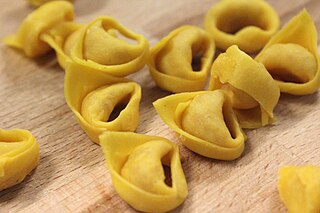
Tortellini is a type of stuffed pasta typical of the Italian cities of Bologna and Modena, in the Emilia-Romagna region. Traditionally it is stuffed with a mix of meat, Parmesan cheese, egg and nutmeg and served in capon broth.

Czech cuisine has both influenced and been influenced by the cuisines of surrounding countries and nations. Many of the cakes and pastries that are popular in Central Europe originated within the Czech lands. Contemporary Czech cuisine is more meat-based than in previous periods; the current abundance of farmable meat has enriched its presence in regional cuisine. Traditionally, meat has been reserved for once-weekly consumption, typically on weekends.
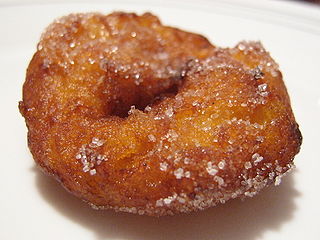
A buñuelo (Spanish:[buˈɲwelo], alternatively called boñuelo, bimuelo, birmuelo, bermuelo, bumuelo, burmuelo, or bonuelo, is a fried dough fritter found in Spain, Latin America, and other regions with a historical connection to Spaniards, including Southwest Europe, the Balkans, Anatolia, and other parts of Asia and North Africa. Buñuelos are traditionally prepared at Christmas. It will usually have a filling or a topping. In Mexican cuisine, it is often served with a syrup made with piloncillo.
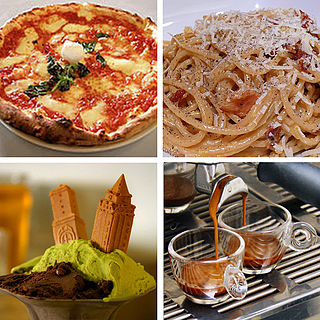
Italian cuisine is a Mediterranean cuisine consisting of the ingredients, recipes, and cooking techniques developed in Italy since Roman times and later spread around the world together with waves of Italian diaspora. Significant changes occurred with the colonization of the Americas and the introduction of potatoes, tomatoes, capsicums, maize, and sugar beet—the latter introduced in quantity in the 18th century. It is one of the best-known and most appreciated gastronomies worldwide.
Kluski is a generic Polish name for all kinds of soft, mushy dumplings, usually without a filling.

Gibraltarian cuisine is the result of a long relationship between the people of Spanish Andalusia and those of Great Britain, as well as the many foreigners who have made Gibraltar their home over the past three centuries. These influences include those of the culinary traditions of Malta, Genoa, and Portugal. This marriage of tastes has produced in Gibraltar an eclectic mix of Mediterranean and British cuisines.
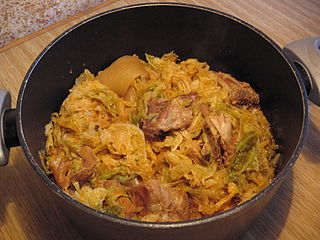
Lombard cuisine is the style of cooking in the Northern Italian region of Lombardy. The historical events of its provinces and of the diversity of its territories resulted in a varied culinary tradition. First courses in Lombard cuisine range from risottos to soups and stuffed pasta, and a large choice of second course meat or fish dishes, due to the many lakes and rivers of Lombardy.

Gnudi, also called malfatti, are gnocchi-like dumplings made with ricotta cheese and semolina instead of potato flour. The result is often a lighter, "pillowy" dish, unlike the often denser, chewier gnocchi. Gnudi is the Tuscan word for "naked", the idea being that these "pillowy" balls of ricotta and spinach are "nude ravioli", consisting of just the tasty filling without the pasta shell.

Dumpling is a broad class of dishes that consist of pieces of cooked dough, often wrapped around a filling. The dough can be based on bread, wheat or other flours, or potatoes, and it may be filled with meat, fish, tofu, cheese, vegetables, or a combination. Dumplings may be prepared using a variety of cooking methods and are found in many world cuisines.

The gnocco fritto or crescentina is an Italian bread from the Emilia-Romagna region of Italy, prepared using flour, water and lard as primary ingredients. Cracklings are sometimes used in its preparation as well. In Emilia-Romagna, it is typically sliced into diamond shapes and then fried, and may be accompanied with cheese and salumi. When it is fried, the bread puffs up, and it may include yeast or baking soda to leaven it. Versions prepared with milk are softer than those prepared with water. It may be served either as an appetizer or as a main dish. Despite the name by which in Italy it is often referred to as a kind of gnocchi, it is technically not.

Cjarsons, also known as cjalsons or cjalzons, are a typical dish of Friulan cuisine, more specifically of the alpine region of Carnia, but also common in the Venetian Plain.
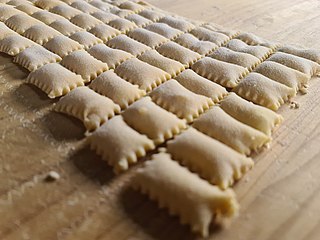
Spoja lorda or stuffed soup is a type of filled egg pasta with a square shape, similar to ravioli. It is typical of Romagna, particularly in the province of Ravenna and Faenza, where it is traditionally served in broth as a first course on holidays. The name spoja lorda derives from the use of the leftover dough from the preparation of cappelletti or, alternatively, from a dialectal expression used to describe a dough with scant filling and, therefore, just "dirty".

















